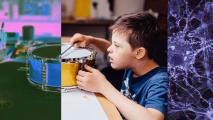The English language contains 44 sounds, and most kids master them all by the time they’re eight years old.
For about one in 12 young children, though, at least one of those sounds is difficult, if not impossible, to pronounce correctly.
Those kids have a speech sound disorder, and the standard treatment is to have the child repeat words containing their problem sound over and over again until they can pronounce it with ease.
This is effective, but it’s also incredibly boring.
Now, the record label Warner Music, creative agency Rothco, and streaming platform Apple Music have teamed up to create a more entertaining speech therapy tool: Saylists.
Sing Along with the Saylist
Each of these 10 music playlists, now available on Apple Music, features songs with lyrics that repeat sounds that are commonly challenging for children.
The “D” Saylist, for example, includes pop artist Dua Lipa’s “‘Don’t Start Now” — it features nearly 50 words with the troublesome sound.
“We recognized that there is one place where many people enjoy the rhythmic repetition of words and sounds — in music,” Rothco CCO Alan Kelly said in a press release.
The idea is that kids can sing along to the Saylist for their particular speech disorder — it lets them practice saying the sound in a way that doesn’t feel so much like practicing.
“Saylists provide a fun, new way (for kids) to practice the sounds I teach them — without feeling pressured or getting bored,” Anna Biavati-Smith, a speech and language therapist who helped create the Saylists, said. “Having fun is the first step to learning.”
Curating the Saylists
After choosing 10 problem sounds to target with the Saylists, Rothco developed a lyric-analyzing algorithm. This algorithm could identify songs that featured the sounds in similar patterns as the words and sentences commonly used during speech therapy.
We believe utterly in music’s ability to change people’s lives for the better.
Tony Harlow
Apple Music then used the algorithm to analyze more than 70 million songs and identify tracks that would fit into each Saylist.
Warner Music and Biavati-Smith then chose the 173 songs included in the 10 Saylists. They specifically looked for songs they thought would appeal to a range of children, but people of any age could take advantage of the Saylists.
“We believe utterly in the power of music and its ability to change people’s lives for the better,” Tony Harlow, CEO of Warner Music UK, said.
“Helping people express themselves is at the heart of what we do,” he continued, “and we hope that by creating a therapeutic tool that’s as engaging and accessible as Saylists, we can help anyone who’s struggling with their speech.”
We’d love to hear from you! If you have a comment about this article or if you have a tip for a future Freethink story, please email us at [email protected].






